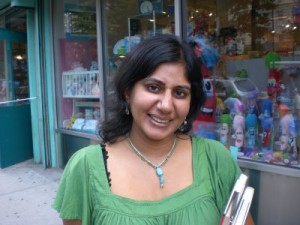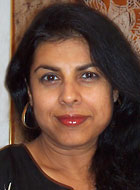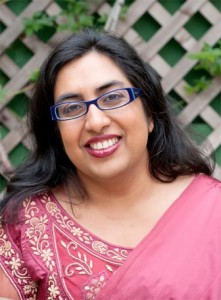 Sandhya Nankani is an award-winning writer, editor, teacher, and curriculum consultant based in New York City. After editing Writing for Teens magazine, founding the teen literary blog WORD, and helping developing Expert 21, a new language arts program at Scholastic over the past five years, in 2008, she founded Literary Safari Inc., a NYC-based editorial services company. Her clients include the New York Times Learning Network, Columbia University’s Teachers College, McMillan’s Feiwel & Friends, Scholastic Education, Weekly Reader Publishing, and The Wright Group/McGraw Hill Publishing.
Sandhya Nankani is an award-winning writer, editor, teacher, and curriculum consultant based in New York City. After editing Writing for Teens magazine, founding the teen literary blog WORD, and helping developing Expert 21, a new language arts program at Scholastic over the past five years, in 2008, she founded Literary Safari Inc., a NYC-based editorial services company. Her clients include the New York Times Learning Network, Columbia University’s Teachers College, McMillan’s Feiwel & Friends, Scholastic Education, Weekly Reader Publishing, and The Wright Group/McGraw Hill Publishing.
Born in Ghana and raised there, in India, and in the US, Sandhya is a graduate of Columbia University’s undergraduate program and its School of International and Public Affairs. She is the editor of the multidisciplinary anthology Breaking the Silence: Domestic Violence in the South Asian-American Community and author of Moments with a Master: Meetings with Dada J.P. Vaswani. A regular contributor to Kahani, the South Asian literary magazine for children, she enjoys writing for children, young adults, and adults. She is the creator of the blog Literary Safari and a contributing writer for Sepia Mutiny, where she reviews adult and children’s books, interviews authors, and ruminates about all things arts, culture, lifestyle, and food related.
Author Interview
How did you choose this path?
I’ve always been the kind of person who doesn’t like to pigeon hole myself to one thing. As a college student and thereafter, I was always on the lookout for a career path that would allow me to engage my multiple interests and skills: education, writing & editing, social and international issues, managing, and entrepreneurship. After stints as a conference organizer and researcher at a university research organization, a freelance journalist, administrator of a writing and tutoring center at an undergraduate college, manager of an urban men’s clothing retail outlet, and editor at a few educational publishing houses over the past 12 years, I finally decided to venture out on my own and start my own editorial services business last summer.
My goal was two-fold: to give myself the opportunity to take on editing and writing projects in the educational, non-profit, and trade publishing realm that might not have come my way if I continued to think of myself as a language arts editor—which is what I’d been focusing on for the past five years—as well as to carve out time and space for my own creative pursuits.
I was born in Ghana to an entrepreneurial Sindhi family so the thought of venturing out on my own was not so much scary as it was inevitable, but still, this has been a big step; one that teaches me something new everyday (especially about self-discipline!).
What is it like to be a multicultural writer in the US? How do you define yourself?
I was born in Ghana and shuttled back and forth between Africa and India, where I went to school until I was twelve years old. It was in 6th grade that my family moved to the US; to a suburban town in NJ where there were only two other Indian-American kids in my class. Though I’ve lived in the US longer than I’ve lived in any other country, when people ask me where I’m from, I don’t ever feel like there’s an easy answer or definition. I’m most certainly American. I’m also Indian. And, there’s quite a bit of Ghana in me as well! I wrote an essay “Sankofa” several years ago which still epitomizes my feelings about my self-definition.
Being a “multicultural writer and editor” who has lived in different social and cultural environments has allowed me to apply my perspective in all my work, something I’ve found it especially useful in the world of educational publishing where it is more and more important to reflect the diversity of America’s social fabric and children’s experiences. So, whether I’m writing a play about immigration, helping create a reading list for middle grade students, or even, just writing a lesson plan or reading guide for a novel or non-fiction book, it helps to be able to view the world both from an insider and outsider point of view.
How did Breaking the Silence and Moments with a Master come into being? What is the inspiration behind your writing?
Both were fortunate accidents waiting to happen! In the case of Breaking the Silence, I was working at a research center at Columbia University the year after I completed graduate school. Part of my job was to organize a conference on domestic violence in the South Asian community where we brought together academics, activists, survivors, and performing artists to share their experiences and resources. This was back in 1997 when the subject of DV was even more taboo within our community than it is today so the notion of a day-long event devoted to recognizing the wonderful work that was being done to combat domestic violence was a noteworthy one.
After the conference, I started transcribing talks and began to speak to my sister, who at the time was working with Manavi, one of the oldest DV organizations in the US. It became increasingly clear to me that all the conversations and dialogue that had begun during that conference needed to be captured somehow, instead of just staying in file cabinets or on film. So, I put together a call for submissions and sat back to see what would happen. The response was overwhelming. Papers, fiction, poetry, artwork, and survivor testimonials poured in.
The logical next step was to write a proposal for a grant to fund the editing and publication and I took Mira Nair’s advice (I’d heard her give a talk about how she funded Salaam Bombay) of approaching the process from the point of view of a pizza pie—divide up the ultimate goal and seek help from as many small organizations and non-profits as possible. Enough funds came through and voila! The book was published using the print-on-demand model offered by Xlibris.com. This reduced the turnaround time of traditional publishing, as well as gave me some help with marketing and distribution (i.e. visibility on amazon.com). Today the book sustains itself. It is still available via Xlibris.com and through second party sellers on amazon, and to my surprise is used in a number of college classrooms and stocked in numerous libraries.
As for Moments with a Master, my grandmother’s guru Dada J.P. Vaswani visited her home in Ghana in 2001. During this visit, I interviewed him for an article in Hinduism Today. One thing led to another and on a subsequent visit to India, I had the opportunity to spend several afternoons with him, my notebook, and a tape recorder, working through a list of questions about life and spirituality. Soon after this visit, I was asked to write a biography of him. I began working on a book and soon found that it was impossible to write a biography without writing about my own encounter with his philosophy from the perspective of a twenty-something Indian-American. This was something that my father, an amazing writer, guided me toward when he read the drafts of my first chapters on a hospital bed at Memorial Sloan Kettering. I took my father’s advice seriously and wrote the book in the months following his passing in late 2001. The book was subsequently published in New Delhi and is now in its second edition.
What can you tell us about Literary Safari. It seems like a true labor of love. How has this blog helped the book world?
I started Literary Safari in 2006 for the simple reason that I wanted to know what it felt like to blog—to figure out how that was different than writing for magazines or on assignment. At first, it was an outlet to write about my personal observations of this and that (with a literary slant, of course), but over the past three years, it has taken on much more focus. It is a space where I review books, interview authors, and explore the literary aspects of my existence, even if it’s writing about something as simple as a cool satchel for carrying books.
I’m not sure how much it has helped the book world! But it’s certainly something that I enjoy doing, at my own pace, on my own terms. You could call me a subscriber to the slow-blogging movement, I suppose, someone who sees my blog more as a webzine than a space for multiple daily updates. That said, I see the value of Twitter (you can follow me at twitter.com/litsafari) as a viable form of microblogging for those days when I’m too harried with deadlines but do have something to say and need a space to say it.
Tell us about your regular ten-minute freewriting exercises? How does that help you as a writer?
I attended a writing workshop in Taos, New Mexico with Natalie Goldberg, author of Writing Down the Bones, several years ago. One of her main prescriptions is the ten-minute freewrite, where you just sit down with a pen, a first line, a question, an idea, or an image, and start writing, and don’t stop for ten minutes (no crossing out even!). Yes, your hand hurts, but it’s pretty incredible what comes out of the exercise, both in terms of what you put down on the paper as well as how it makes you feel. (It’s much easier to sit down and write a story, article, or play when I know I have a deadline and an editor to report to but it’s a whole other story when it comes to my own working manuscripts!) The ten-minute freewrite has turned out to be a great cure for that ailment we call writer’s block, or the lethargy that sometimes comes over me when it comes to my own creative work.
What is new and current with you and what is next?
Well, I’ve had a fun first year as an independent editor, working on a number of projects ranging from creating a curriculum guide for an oral history of NYC Muslim youth for Teachers Colllege and regular lesson plans for the New York Times Learning Network to writing reader guides for paperback middle grade novels such as Home of the Brave, by Katherine Applegate and the forthcoming Everything For a Dog, by Ann M. Martin and short stories for a third grade reading program to be published by the Wright Group.
Right now, I’m heading up the content development for the new website of Columbia University’s Teachers College’s Student Press Initiative, which should launch this fall (along with my business website). I’m also trying to catch up on some summer reading (i.e. blog more), working on a children’s book manuscript … and sharpening my pencils so that when I become a first-time mother this September, I have lots of original stories ready to tell my baby during those crucial first years!








